
10483
.pdf The reason for this ―missing trade‖ appears to be the assumption of identical technology among countries.
The reason for this ―missing trade‖ appears to be the assumption of identical technology among countries.
Technology affects the productivity of labor and therefore the value of labor services.
A country with high technology and a high value of labor services would not necessarily import a lot from a country with low technology and a low value of labor services.
Summary
1.Substitution of factors in the production process generates a curved PPF.
When an economy produces a low level of a good, the opportunity cost of producing that good is low.
When an economy produces a high level of a good, the opportunity cost of producing that good is high.
2.When an economy produces on its PPF, the opportunity cost of producing a good equals the relative price of that good.
3.If the relative price of a good increases, then the real wage or rate of return of the factor used intensively in the production of that good increases, while the real wage or rate of return of the other factor decreases.
4.If we hold output prices constant as a factor of production increases, then the supply of the good that uses this factor intensively increases, and the supply of the other good decreases.
5.An economy will export goods that are intensive in its abundant factors of production and import goods that are intensive in its scarce factors of production.
6.The Heckscher-Ohlin model predicts that relative output prices and factor prices will equalize, neither of which occurs in the real world.
61
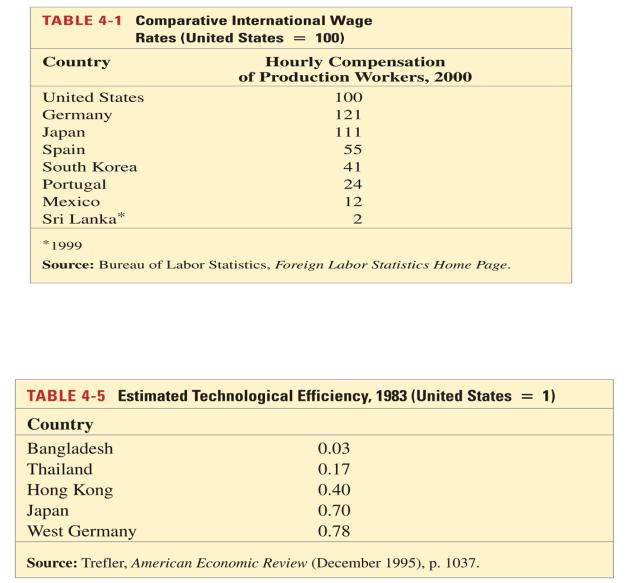
7.The model predicts that owners of abundant factors gain, but owners of scarce factors lose with trade.
8.A country as a whole will be better off with trade, even though the model predicts that owners of scarce factors will be worse off without compensation.
9.Empirical support of the Heckscher-Ohlin model is weak except for cases involving trade between high income countries and low/middle income countries.
62

63
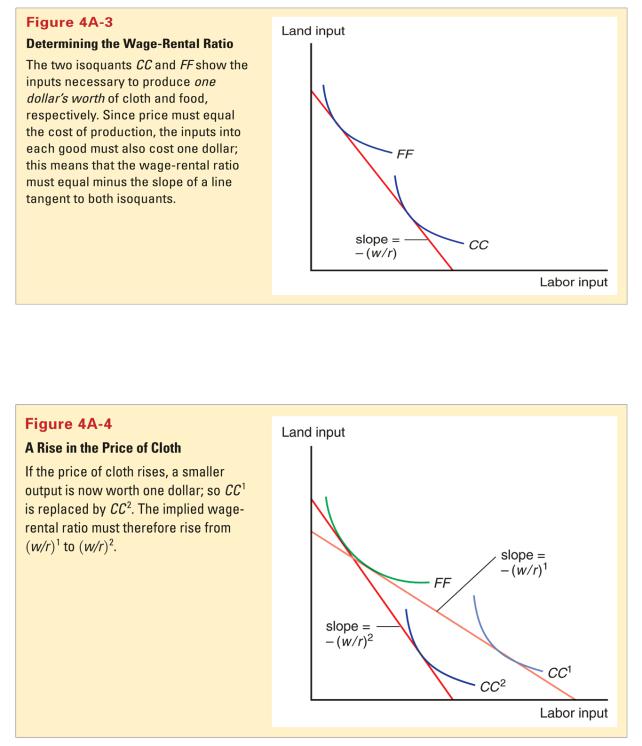
64
Chapter 5
The Standard Trade Model
Preview
 Measuring the values of production and consumption
Measuring the values of production and consumption
 Welfare and terms of trade
Welfare and terms of trade
 Effects of economic growth
Effects of economic growth
 Effects of international transfers of income
Effects of international transfers of income
 Effects of import tariffs and export subsidies
Effects of import tariffs and export subsidies
 Income distribution
Income distribution
Introduction
 The standard trade model combines ideas from the Ricardian model and the Heckscher-Ohlin model.
The standard trade model combines ideas from the Ricardian model and the Heckscher-Ohlin model.
1.Differences in labor, labor skills, physical capital, land and technology between countries cause productive differences, leading to gains from trade.
2.These productive differences are represented as differences in production possibility frontiers, which represent the productive capacities of nations.
3.A country’s PPF determines its relative supply curve.
4.National relative supply curves determine world relative supply, which along with world relative demand determines an equilibrium under international trade.
65
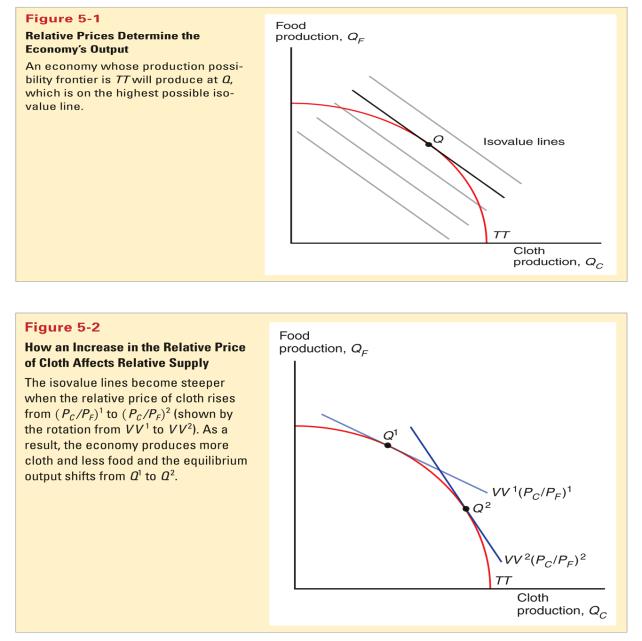
The Value of Production
 Recall that when the economy maximizes its production possibilities, the value of output V lies on the PPF.
Recall that when the economy maximizes its production possibilities, the value of output V lies on the PPF.
 V = PCQC + PF QF describes the value of output in a two good model, and when this value is constant the equation’s line is called and isovalue line.
V = PCQC + PF QF describes the value of output in a two good model, and when this value is constant the equation’s line is called and isovalue line.
The slope of any equation’s line equals – (PC /PF), and if relative prices change the slope changes.
66
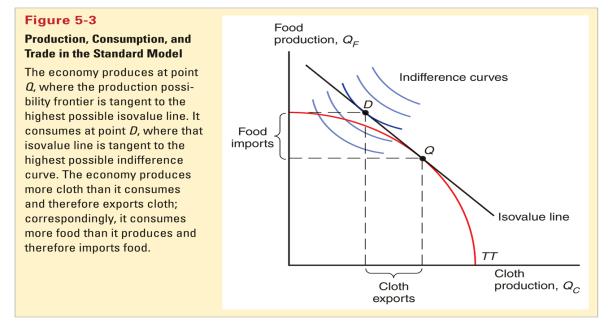
The Value of Consumption
 The value of the economy’s consumption is constrained to equal the value of the economy’s production.
The value of the economy’s consumption is constrained to equal the value of the economy’s production.
PC DC + PF DF = PC QC + PF QF = V
 Production choices are determined by the economy’s PPF and the prices of output.
Production choices are determined by the economy’s PPF and the prices of output.
 What determines consumption choices (demand)?
What determines consumption choices (demand)?
 Consumer preferences and prices determine consumption choices.
Consumer preferences and prices determine consumption choices.  Consumer preferences are represented by indifference curves: combinations of goods that make consumers equally satisfied (indifferent).
Consumer preferences are represented by indifference curves: combinations of goods that make consumers equally satisfied (indifferent).
 Indifference curves are downward sloping to represent the fact that if a consumer has more cloth he could have less food and still be equally satisfied.
Indifference curves are downward sloping to represent the fact that if a consumer has more cloth he could have less food and still be equally satisfied.
 Indifference curves farther from the origin represent larger quantities of food and cloth, which should make consumers more satisfied and better off.
Indifference curves farther from the origin represent larger quantities of food and cloth, which should make consumers more satisfied and better off.
67

 Indifference curves are flatter when moving to the right: the more cloth and the less food that is consumed, the more valuable an extra calorie of food becomes relative to an extra m2 of cloth.
Indifference curves are flatter when moving to the right: the more cloth and the less food that is consumed, the more valuable an extra calorie of food becomes relative to an extra m2 of cloth.
Prices and the Value of Consumption
 Prices also determine the value of consumption.
Prices also determine the value of consumption.
When the price of cloth rises relative to the price of food, the economy is better off when it exports cloth: a higher indifference curve results.
A higher price for cloth exports means that more food can be imported.
A higher relative price of cloth will also influence consumption decisions about cloth versus food: a higher relative price of cloth makes consumers willing to buy less cloth and more food.
 The change in welfare (income) when the price of one good changes relative to the price of another is called the income effect.
The change in welfare (income) when the price of one good changes relative to the price of another is called the income effect.
The income effect is represented graphically by shifting the indifference curve.
68
 The substitution of one good for another when the price of the good changes relative to the other is called the substitution effect.
The substitution of one good for another when the price of the good changes relative to the other is called the substitution effect.
This substitution effect is represented graphically by a moving along a given indifference curve.
Welfare and the Terms of Trade
 The terms of trade refers to the price of exports relative to the price of imports.
The terms of trade refers to the price of exports relative to the price of imports.
When a country exports cloth and the relative price of cloth increases, the terms of trade increase or ―improve‖.
 Because a higher price for exports means that the country can afford to buy more imports, an increase in the terms of trade increases a country’s welfare.
Because a higher price for exports means that the country can afford to buy more imports, an increase in the terms of trade increases a country’s welfare.
 A decrease in the terms of trade decreases a country’s welfare.
A decrease in the terms of trade decreases a country’s welfare.
Determining Relative Prices
 To determine the price of cloth relative to the price food in our model, we again use relative supply and relative demand.
To determine the price of cloth relative to the price food in our model, we again use relative supply and relative demand.
relative supply considers world supply of cloth relative to that of food at each relative price
relative demand considers world demand of cloth relative to that of food at each relative price
In a two country model, world quantities are the sum of quantities from the domestic and foreign countries.
69
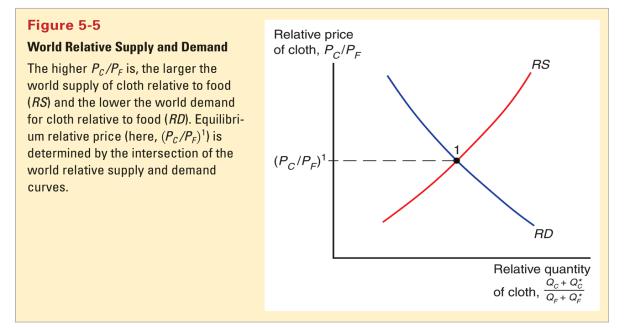
The Effects of Economic Growth
 Is economic growth in China good for the standard of living in the US?
Is economic growth in China good for the standard of living in the US?
 Is growth in a country more or less valuable when it when it is integrated in the world economy?
Is growth in a country more or less valuable when it when it is integrated in the world economy?
 The standard trade model gives us precise answers to these questions.
The standard trade model gives us precise answers to these questions.  Growth is usually biased: it occurs in one sector more than others, causing relative supply to shift.
Growth is usually biased: it occurs in one sector more than others, causing relative supply to shift.
Rapid growth has occurred in US computer industries but relatively little growth has occurred in US textile industries.
According to the Ricardian model, technological progress in one sector causes biased growth.
According to the Heckscher-Ohlin model, an increase in one factor of production (e.g., an increase in the labor force, arable land, or the capital stock) causes biased growth.
70
